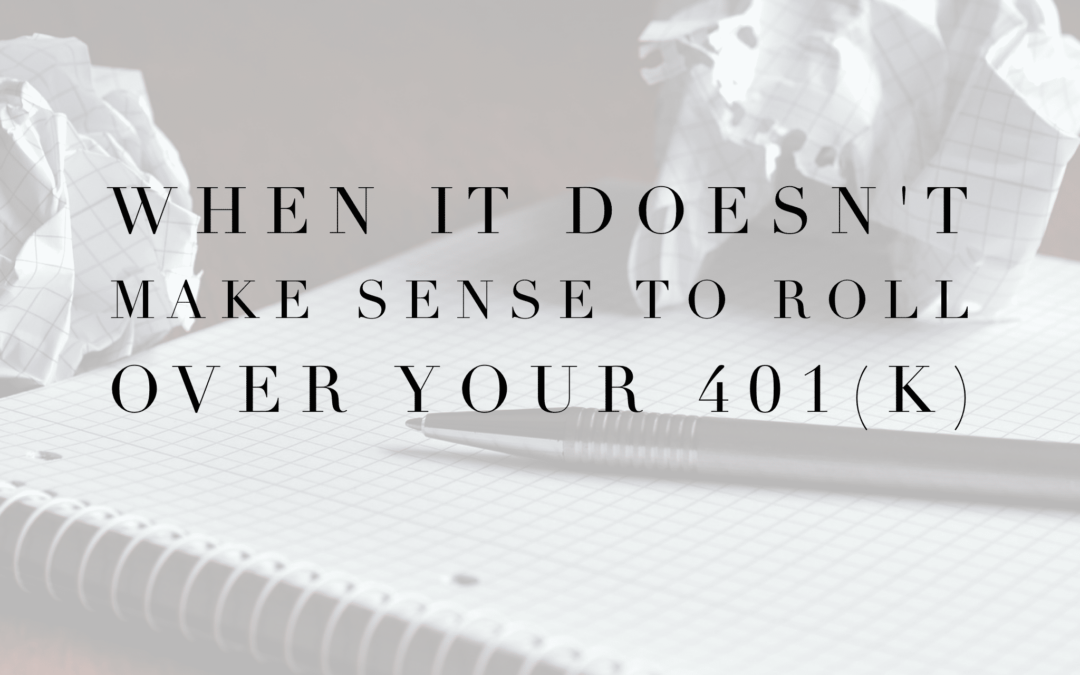Financial advisors are quick to encourage individuals transitioning into new jobs or who are near retirement to roll their 401(k) account into an IRA. But is a rollover always your best option? While it’s a popular move, that doesn’t mean it automatically makes sense for everyone.
If you check any of the following boxes, that’s an indication that you need to slow your rollover plans and potentially consider other choices for your 401(k).
Your Plan Is Cheaper Than an IRA
This is a black and white issue that was made easier a few years ago when fee disclosure on 401(k) plans became a required practice in 2011.
The all-in costs of your 401(k) plan are listed on your quarterly statements. In addition to expense ratios on mutual funds, take note of the fees paid to the investment advisor, third party administrator, and recordkeeper.
If you work at a company with over 50 employees, there is a good chance that your all-in cost is less than 1.00%. That includes fund expenses, advisor fees, and administration costs. Smaller plans might expect to see total cost around 1.00% to 1.50%.
When a financial advisor recommends rolling over your 401(k) into an IRA, you should ask what the all-in cost is to you including expense ratios, transaction costs, and management fees. If your advisor is unable or unwilling to provide a transparent breakdown of your all-in costs, you should probably keep the assets in the plan.
If your plan is only slightly cheaper than rolling into an IRA, then you might decide that the benefits of consolidation or a particular investment strategy can make some additional cost acceptable.
You Don’t Have Access to a Financial Advisor Who Always Acts as a Fiduciary
Last April, the Department of Labor (DOL) released rules requiring anyone offering retirement savings advice to act in a fiduciary capacity, which means that the client’s best interest must come first. While it’s unclear whether the current administration will water down this rule or completely retract it, you shouldn’t roll out 401(k) assets to someone unless they act as a fiduciary at all times regardless if the government upholds the DOL rule.
Once you understand the difference between fiduciary and suitability standards, it becomes obvious that you want to work with a fiduciary at all times. The problem these days is that the word “fiduciary” gets thrown around casually by all providers of financial advice – regardless of whether they actually uphold the standard in everyday interactions with clients.
There is a group of advisors regulated by the SEC that must act in a fiduciary capacity at all times. Meanwhile, registered representatives are regulated by FINRA and held to the suitability standard. People selling insurance products are held to a standard that’s even more lax than the suitability one.
How can you tell the difference? Ask to see your advisor’s Form ADV. If they don’t have one, they aren’t required by law to act as a fiduciary at all times. Bonus points for advisors that go the extra mile with their fiduciary duty and get certified by the Centre For Fiduciary Excellence.
You Plan on Doing a Roth Conversion in the Future
Converting IRAs to Roth IRAs has become a popular financial planning technique the past few years for investors looking to manage future tax liabilities. When you convert an IRA to a Roth IRA, you pay ordinary income taxes on your pre-tax contributions as well as the gains you’ve earned on all contributions. Once the assets are in a Roth IRA, you enjoy tax deferred growth and tax free withdrawals.
This is a useful planning strategy for people who are in a low income bracket at the year of conversion but expect to be in a higher income bracket when the assets are eventually withdrawn in the future. Others perform Roth conversions with the intention of never spending those assets and leaving them to heirs.
The Roth conversion strategy tends to be most efficient when there isn’t much appreciation in your IRA. If you are rolling over a 401(k) at retirement or in transitioning jobs after many years at a company, you’ll increase the portion of pre-tax contributions eligible for taxation and also likely have significant appreciation that would be subject to tax in the event of a Roth conversion.
Additional Benefits of Staying in the Plan
There are a few additional benefits of a 401(k) versus a IRA that might tip the scale if the above considerations don’t yield an obvious answer. For example, 401(k) accounts are generally protected from creditors – except the IRS and your spouse – whereas rollover IRAs are protected in bankruptcy, but not from creditors.
Additionally, there is an earlier age at which you can withdraw from a 401(k) without penalty. With an IRA, you have to wait until age 59 ½ to make penalty free withdrawals. In a 401(k) account, you only need to be age 55 to begin making withdrawals assuming you are no longer with the company.
















Question on your 401K conversion discussion. I think you are saying that if you have an existing tIRA that you plan to rollover to a Roth IRA, that you should do that before transferring any portion of your 401K to the tIRA? I think you are saying that for the funds already inside the 401K, it doesn’t really matter when you roll over to tIRA then a Roth IRA, but you want to clear out everything in the tIRA first to take advantage of the fact that generally a tIRA has a smaller tax ratio (% of assets subject to tax) than your 401(k) will. Is this accurate? I’m just starting to learn about this topic a little.
Regarding to conversion from 401k to Roth IRA, why did u make a distinction between contribution and appreciation? I thought both would be treated as ordinary income. Am I mistaken? Thanks